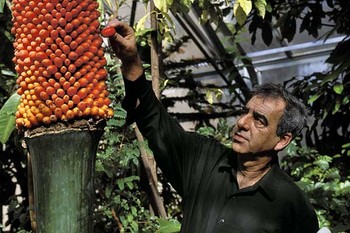Campus botany gardener: transplant master
Mo Fayyaz, director of the Botany Garden and Greenhouse at UW–Madison, displays leaves of the titan arum. Called a “corpse flower” for its death-like stench, its blooming in 2001 attracted throngs to the greenhouse.
Photo: David Tenenbaum
To hear master gardener Mo Fayyaz tell it, raising plants is straightforward: Get the right light, temperature, soil and water. Keep your eyes open. If one thing doesn’t work, try something else. And if everything fails, choose another plant. “You cannot just plant a rose in the shade and expect much,” he says.
Fayyaz has applied that practicality to his personal life as well. After all, a native of Iran, Fayyaz did not intend to stay in the United States after he received his Ph.D. in horticulture/botany at UW–Madison in 1977. Instead, he took his new American wife, a nurse, to Tehran and began teaching horticulture at his alma mater, Tehran University.
Then history got in the way.
In 1979, rebels overthrew the Shah of Iran and seized hostages at the U.S. Embassy. By the next year, with Iran and Iraq at war, his wife visited her parents in Wausau, Wis. In 1981, Fayyaz finished teaching the semester and joined her. The war was raging, so their decision was obvious: “We had to start working here,” Fayyaz says.
By 1984, Fayyaz secured his present job, director of UW-Madison’s Botany Garden and Greenhouse, and he began a long campaign to nurture and expand a garden that supports teaching and research in the biological sciences.
What are the plant master’s favorite plants? ‘Like any other botanist, I don’t discriminate,’ Fayyaz says. ‘I love them all.’
Although the garden suffered through a hard winter this year, Fayyaz notes that it’s doing pretty well overall despite losing a couple of roses and a flowering cherry. Ironically, cold tolerance was the subject of his long-ago dissertation.
Fayyaz is an energetic man who moves purposefully, but his sense of humor never seems deeply hidden. In recognition of dual passions for horticulture and botany, he sometimes calls himself a “Ho-Bo.”
After a full day of coaxing plants to life, however, he does little gardening at home. “We have a saying in Iran,” Fayyaz explains. “The potter usually drinks from the broken pot.” But does he have a green thumb? “No,” he says. “You are not born with all of it — it’s not an instinct. You need to be observant, and you need experience.”
Fayyaz credits his mother, who gardened in the small yard in Tehran, as an early influence. “She was an avid horticulturist, always had flowers, to the point of perfection. She could not handle one dead leaf in the garden, and that part of me came from her.”
Fayyaz appreciates variety in his job. “I can do research, teach and hands-on work in the greenhouse and garden. It’s not just time in a lab.”
Although he tries to make gardening sound easy, the Botany Garden — with its 500-plus species — is anything but simple. Located along University Avenue behind Birge Hall, which houses the botany department, Fayyaz says it was the “first garden in the world to be based on angiosperm phylogeny,” a molecular classification system of plants.
The flowering plants are also arranged genetically, which groups related plants for easy comparison. The organization also helps the garden support its primary mission: providing plant samples for 14 biology courses. More than 1,000 species live in the botany greenhouse, Fayyaz says.

Mo Fayyaz harvests “corpse flower” fruit after the plant’s blooming in 2002. “How this beast behaves at every step is educational,” he says.
Photo: Michael Forster Rothbart
And what are the plant master’s favorite plants? “Like any other botanist, I don’t discriminate,” he says. “I love them all.” Still, he admits that first among equals is the titan arum — the “corpse flower” whose blooming in 2001 attracted 30,000 visitors, plant fanatics and neophytes alike, to the greenhouse. That was the first bloom for the Sumatra native plant in Madison, whose 8-foot tall inflorescence earned its botanical name, “Amorphophallus titanum.”
Beyond its titillating form, the titan arum embodies its evolution: Its powerful stench, for example, evolved to attract pollinating flies. “How this beast behaves at every step is educational, from seed to flower to seed again,” Fayyaz says.
However, gardening is changing due to the digital revolution, Fayyaz adds. “Everyone wants to see and identify plants in Wikipedia. But students in the past couple of years seem hungry to know how to do things. I have volunteers from botany and horticulture who say, ‘We want to hold that shovel.’ Maybe we are getting to the saturation point of this fascination with electronics. Botany without plants is like a car without a wheel.”
Tags: horticulture, plants



